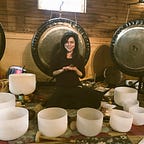The Experiencer’s Guide to the Galaxy
“So you’ve had an anomalous experience. Something has happened that has forced you to reevaluate your sanity or reality as you knew it. Rest assured, reality is certainly not what you thought it was up until now and the answers to all those new questions you have lie within. Most importantly you are not alone, so let’s begin the journey inward with a roadmap towards integrating and evolving with this fresh perspective, and connecting with resources for thriving!” — You’re Not Crazy
Introducing a trauma-informed approach to integration of anomalous experiences is an area of research which requires more practical and monetary investment. The introductory section of a new, free pamphlet quoted above is one of many first collaborative steps on our journey into the forest through the trees of resolution and integration of anomalous and possibly traumatic events. As with any ground-breaking research in the sciences, more peer-reviewed research is necessary in the relatively recently developed field of parapsychology, and practical applications and resources are forthcoming.
As organizations attempt to produce and compile reproducible studies a need for collaboration and perspective has arisen, not to mention a gap in research funding allocated to quantizing anomalous information reception as IONS research director Dr. Helané Wahbeh has admirably set out to do. In her research paper, Qualitative accounts of first-person accounts of noetic experiences she states “Future research will include investigating the nuances of these themes and also establishing standardized methods for evaluating them. This would also then inform curricula and therapies to support people in these experiences.” A diverse range of professionals are coming together to address the study of the unseen through an investment into a new understanding of old physics such as The Bigelow Institute of Consciousness Studies’ (BICS) grant funding opportunity for evidence of the “Afterlife,” and the well-known Theories of Everything [TOE] with Curt Jaimungal’s Physics and Consciousness Explication Contest (#PaCE1.) The peer-reviewed, published results of initiatives such as these continue to build the foundation for further interest and investment into anomalous events and information reception.
One collection of driven scientists, veterans, experiencers of anomalous activity and others led by retired fighter pilot turned Unidentified Aerial Phenomena (UAP) Investigator Chris Lehto is UAP Society. Lehto has not only founded a thriving and continuously growing community for interdisciplinary collaboration on Discord, but recently published a summation of his own TOE which he is submitting to Jaimungal’s contest in a joint effort “to have more disquisitions on topics that don’t have readily digestible tutorials out there” in Jaimungal’s words, or in layman’s terms to further a new grasp of physics to get to the bottom of the hard problem of consciousness.
“Consciousness Resonates in Octaves Like Music?” is the title of Lehto’s duly-formed hot take on the hard problem. In it he ties together theories of sound, light and frequencies, connecting concepts through bands of electromagnetic constructs of consciousness itself such as “The electromagnetic waves in each of these bands have different characteristics, such as how they are produced, how they interact with matter, and their practical applications. There is no known limit for long and short wavelengths.” He even incorporates Donald Hoffman’s theory of consciousness which is expounded upon in The Case Against Reality, where he states,
“Perception is not a window on objective reality. It is an interface that hides objective reality behind a veil of helpful icons.” — Donald Hoffman
Anomalous events occur with surprising regularity as Diana Walsh Pasulka, doctor of religious studies, points out in American Cosmic, stating “More than half of American adults and more than seventy-five percent of young Americans believe in intelligent extraterrestrial life. This level of belief rivals that of belief in God.” Technological evolution has made it possible to collect and interpret data through various modalities of anomalous information reception. In the aforementioned study published by Dr. Wahbeh, several ways of knowing, or receiving, qualitative information from beyond the veil were categorized which reflect a spectrum of sensory reactions to anomalous experiences. As peer-reviewed results confirm a very physical basis for a historically psychologically stigmatized experience of worldview changing, noetic phenomena, the gap in practical applications of this information in supporting treatment and integration techniques in a clinical setting for experiencers of such anomalous phenomena becomes glaringly obvious.
One forthcoming research experiment designed to amplify and quantify anomalous information reception from the “Afterlife” is proposing to use funding from the upcoming BICS grant opportunity, and aims to ensure participants are provided with resources for integrating the noetic experience, drawing from a compilation of support and educational materials from parapsychological and psychological organizations to experiencer groups and reporting centers. Bringing together a diverse set of research modalities to understand and apply research into anomalous phenomena can be a springboard for further interdisciplinary collaboration, especially as monetary investment is allocated to studying the pervasive effects of reality that many perceive in what may previously have been considered to be an unorthodox manner.
Groups like UAP Society and BICS are quickening the pace of consciousness evolution through decentralized opportunities to bring together a diverse collective of professions and perspectives. You’re Not Crazy is one such small step to decentralize and disseminate research into anomalous phenomena as a starting point to empower humankind to shed light through the transparent veil of reality as we perceive it.
